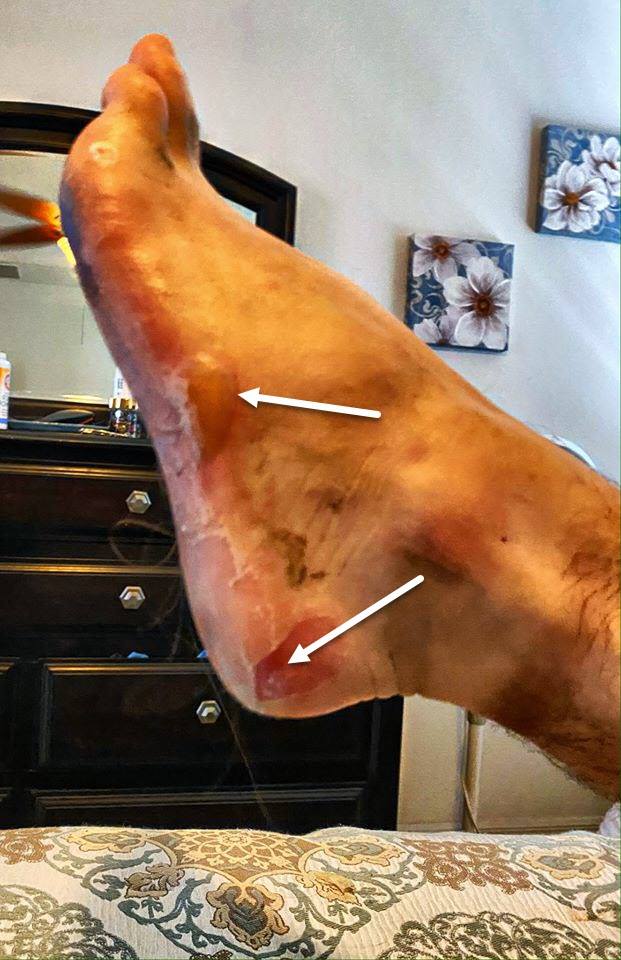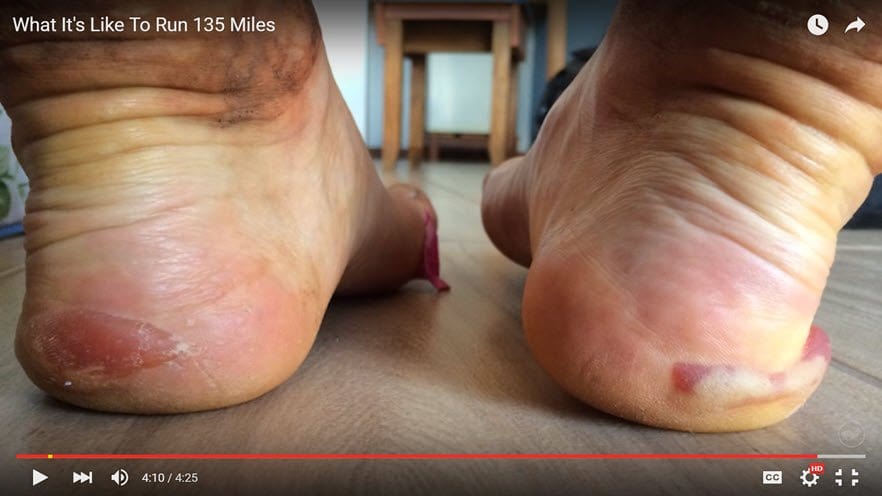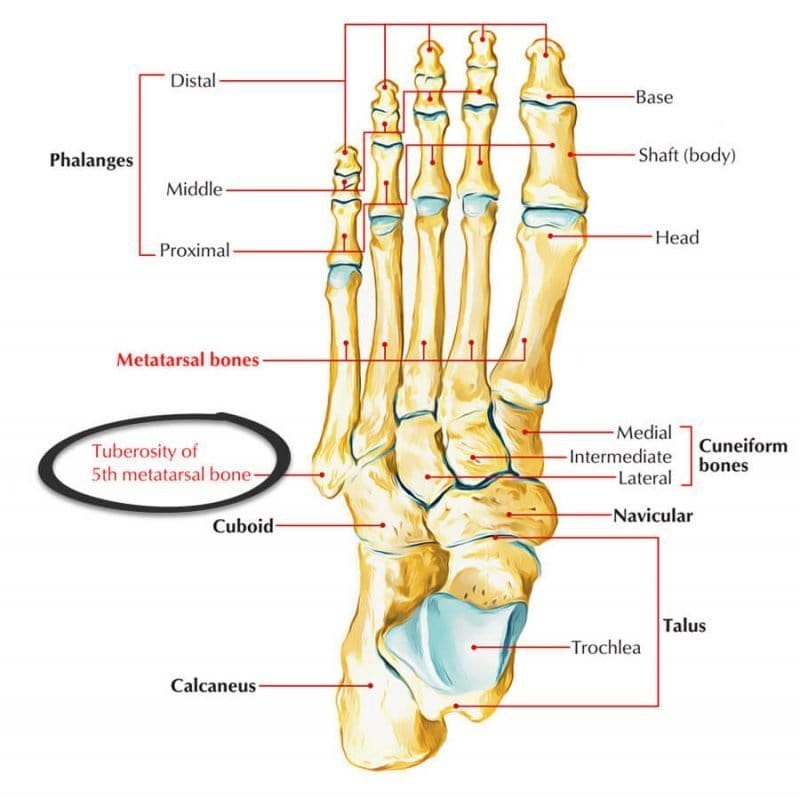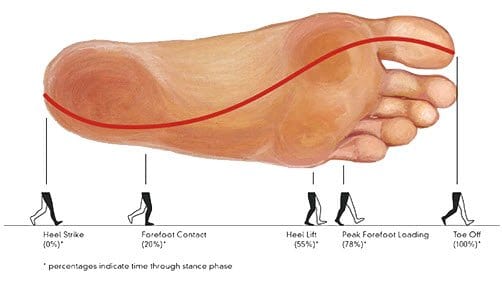Cas posted in an Ultrarunning Facebook group a question about lateral midfoot and styloid process blisters:
“Has anyone had blisters here before (picture above)? I've got have these on both feet. I think it is due to my landing position. I have a football background and I land with the outer part of my foot first. Ever since I ran my first marathon, I have been trying to change the landing. In the future, wanting to run further distances, having this big of a blister would surely mean an early exit!”
Similarly, Richard added a photo of his lateral (outer edge) edge blisters. He’s got one at the heel (lower arrow) and one at the styloid process (the top arrow pointing to the middle of the foot).

Richard's styloid process edge blister (top arrow)

135 miles on the Caminho De Fe in Brazil.
Lateral midfoot anatomy
The styloid process is quite a bony prominence at the best of times (see tuberosity of 5th metatarsal bone). This bony prominence is really obvious (and completely normal) in some people compared to others. Yours might not look that lumpy, but feel for it – it’s half way between your heel and little toe.

Bones of the foot (courtesy of Earth's Labs). The styloid process is named the tuberosity of the 5th metatarsal.
Cause of styloid process blisters
Irritation from the lateral cup of your insole or orthotic causes styloid process blisters. The irritation is a combination of:
- Pressure - as in there’s a mismatch between the shape of your foot and the shape of your insole resulting in localised high pressure to the skin over the bony prominence.
- And friction – as in there’s a high friction level here between the insole material, your sock and your clammy skin. This is a given when you are exercising.
It’s the same with heel edge blisters. Heel edge blisters (either on the medial, rear or lateral side of the heel) are much more common because the heel cup is usually more pronounced and higher. Imagine if the heel cup of the insole (or orthotic) is either thick, rough, folded or the whole thing has slid forward in your shoe and your heel is sitting “on” the heel cup instead of “in” the heel cup! There’s going to be a spot of really high pressure. Here’s that article on heel edge blisters.
Why aren’t styloid process blisters (and lateral midfoot blisters generally) very common?
It’s normal to land a relatively on the outer side of your foot when you walk and run, generally speaking. The foot then pronates so that you can toe-off through the big toe. Here’s a depiction of the centre of pressure from heel strike to toe-off.

A depiction of how the centre of pressure (COP) moves from heel to toe (Footmaxx)
It’s also normal to run with a narrower base of gait compared to walking. Your feet are closer to the midline, initial ground contact is likely to be more lateral (on the outer side of the foot).So in a way, it’s surprising we don’t see more lateral midfoot blisters. I suspect it’s because the lateral column is a relatively stable part of the foot - bone movement is minimal compared to the medial column (arch). Also, the midfoot doesn’t sustain the large braking forces of the heel or the large propulsive forces of the ball of the foot. Both of these scenarios see a large bony excursions relative to the skin in conditions of high friction levels. Remember, it’s the mismatch in bone movement relative to the skin that causes blisters (Richie, 2010).
Styloid process blister prevention
Pressure
Definitely take a look at the lateral lip of your insole or orthotic. It's likely to be problematic if it doesn’t match the shape of your foot, if it’s rough or worn, and especially if it’s rigid (like the lateral edge of an orthotic could be). I’d get that sorted by either cutting away that bit of the insole, getting a new insole altogether, or by seeing your podiatrist who might be able to grind, heat-gun or smooth this area.
Friction
I would also reduce friction levels with Engo Blister Patches using the two-patch technique (one on the insole, one on the shoe).
Should you change your gait?
Lateral initial ground contact and runner’s varus are normal, so this is a tricky one to answer. It wouldn’t be the first thing I’d do – I’d take care of pressure and friction first. If that doesn’t help enough, I’d suggest seeing a podiatrist or physiotherapist to get some advice on whether changing your gait is likely to help in your situation and how to do it safely. Always ease into gait changes gradually because going gung-ho can give you new problems or injuries to deal with.Certainly, gait retraining can help certain musculoskeletal conditions like shin splints (medial tibial stress syndrome). Here’s some fabulous insight from Ian Griffiths into how running with slightly less of a runner’s varus can help shin splints. If you want to fast forward to the gait retraining part, you can start watching at 8 minutes.
Wrapping up
I’ve got to say, it's not very common to see edge blisters around the styloid process or lateral midfoot. If you do get them, you’ll need to look at the shape of your insole or orthotic, reduce friction levels, and maybe think about how your foot contacts the ground.








